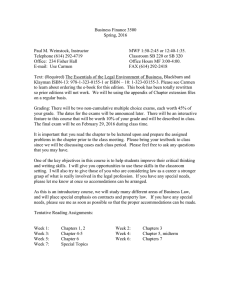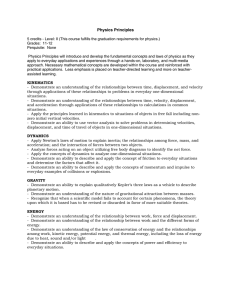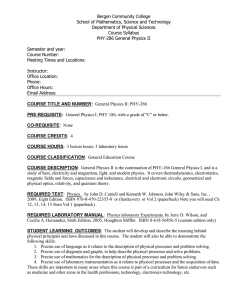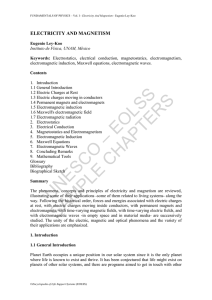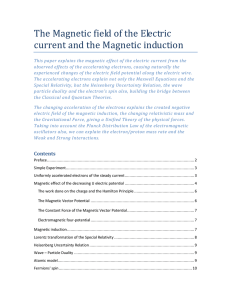EE 100 Electrical Engineering Concepts
advertisement
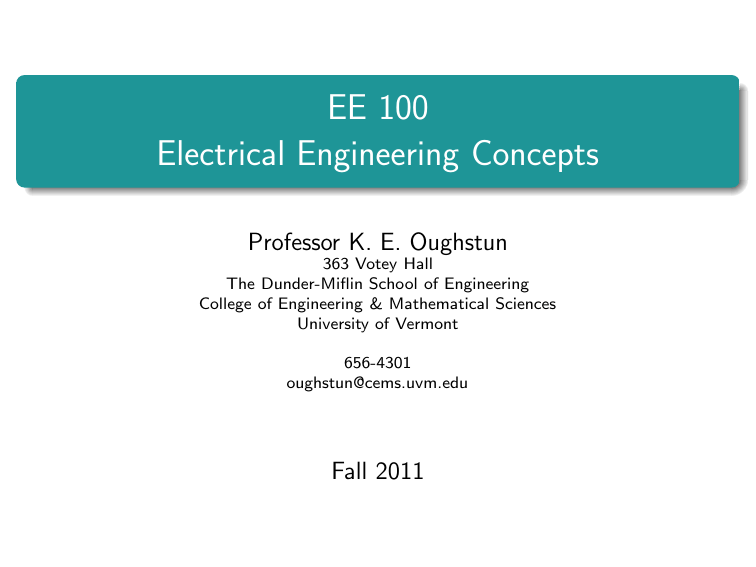
EE 100 Electrical Engineering Concepts Professor K. E. Oughstun 363 Votey Hall The Dunder-Miflin School of Engineering College of Engineering & Mathematical Sciences University of Vermont 656-4301 oughstun@cems.uvm.edu Fall 2011 Motivation Course Information Course Description (UVM 2009–2010 Catalogue) Introduction to analog and digital electrical measurements and circuits; introduction to microprocessors. (Four Credit Hours) Prerequisites: Physics 125. Class Time: MWF 9:35–10:25 (103 Rowell). Instructor Office Hours: MW 10:30–12:00 noon & by appointment. Text: Giorgio Rizzoni, Principles & Applications of Electrical Engineering, McGraw-Hill. Supplemental Text: Dolores Etter, Engineering Problem Solving with MATLAB, Prentice-Hall. Prerequisite Physics Text Level: R. Wolfson & J. Pasachoff, Physics for Scientists & Engineers, Addison-Wesley. Prerequisite Calculus Text Level: J. Stewart, Calculus, Brooks/Cloe Pub. Co. (1995). Course Outline Chapter 1. Introduction - Review Chapters 23–24 of W & P. Chapters 2–4. Basic Circuit Analysis - Review Chapters 28 & 33 of W & P. Chapter 5. Transient Analysis. Chapter 5. Steady State Power Analysis & Transmission Lines Review Chapter 31 of W & P. Chapter 6. Frequency Response & System Concepts - Review Chapters 15 & 33 of W & P. Chapter 7. AC Power. Additional Topics (time permitting). The Nature of Electromagnetism Electric and magnetic fields are fundamentally fields of force that ultimately originate from electric charge. Whether this force field is referred to as electric or magnetic or electromagnetic hinges upon the motional state of the electric charge relative to the point at which the field observation is made. This engineering science subject matter then naturally involves the Special Theory of Relativity. Electric charges at rest relative to the observation point give rise to an electrostatic field at that point. A relative motion of the charges results in a convective current and provides an additional magnetic force field. This additional field is a magnetostatic field if the charges are all moving at constant velocities relative to the observation point. If the charges undergo accelerated motions, both time-varying electric and magnetic fields are produced that are coupled; they are then referred to as an electromagnetic field. Microwave Link Electromagnetic Spectrum Radio Frequency Bands Student Performance Assessment Problem Assignments: Problems will be assigned on Monday of each week and are due the following Monday. Each student is required to develop their own individual solution to each assigned problem. Students are encouraged to discuss these problems with their classmates in developing their solution, but are forbidden from simply copying someone else’s solution (plagiarism). Chapter Exams: There will be a 50 minute class exam at the conclusion of each chapter grouping. All exams are closed book. Notes, electronic calculators, laptops, etc. are not permitted. Each chapter exam (there will be, at most, 6 of them) will count 10% of the final grade. Student Performance Assessment Grading: Each chapter exam contributes equally to 60% of your final grade in the 3 credit lecture part of the course. Graded homework counts for 20% of your final grade in the 3 credit lecture part of the course. The final exam counts for 20% of your final grade in the 3 credit lecture part of the course. Final Exam: Monday, December 12, 2011; 10:30 AM–1:15 PM; Rowell 103. Please note that all exams are closed book, no notes, no electronic calculators, no laptops, etc. Excuses to Avoid Rules of Class Etiquette Class attendance and on-time arrival at the start of class is expected. Absences may result in a decrease in individual performance assessment (i.e. your grade). You are responsible for obtaining any missed lecture notes from your fellow students. I will not provide them. Talking between students during the lecture is frowned upon =:∼ ( Cell phone, texting, twittering, and other PDA use during class is strictly forbidden. Any food brought into class must be shared. Rules of Class Etiquette Please do ask questions during class about the lecture. They may help to clarify the topic not only for you, but for others in the class as well. Please try not to email me with questions about the course. Ask them in class instead so that all may benefit. Back in the 1960’s when I was an undergraduate, the Professor lorded over the class and the students suffered at his or her whim. Today, university administrators view the students as customers and the faculty as their servers (or facilitators). Both of these extreme points of view are wrong.


